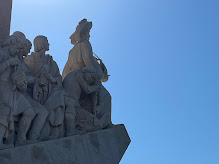 |
| Belém Tower on the Tagus, part of old fortifications |
Lisbon--After whopping big breakfast for John and fruit for Ben, we boarded our bus. Our host this morning, as well as tour director, was a smart, affable and articulate Agnes, an alfacinha who told us she grew up in central Lisbon and had spent three years learning to be a guide. And she knows her stuff. We learned Portuguese art, style and history in our four hours of travel together.
Our first stop, after a couple of photo ops from views over the city, was the Belém Tower. Ben and I had been to this building on the Tagus 39 years ago and found it much more organized for tourists than in 1983. The same could be said for the monument to the explorers, celebrating, among others Prince Henry the Navigator and his role in Euro-centric imperialism and exploration. His role in building knowledge of the oceans and how to get to India for trade helped build the Portuguese Empire, which held territories in Africa, Asia and South America at its height.
Prince Henry the Navigator
 |
| Pombal's work |
Following on with our history lesson included a visit to the monastery of St Jeronimo, which was built in the late Gothic style known as Manueline after the ruling monarch King Manuel. It housed monks until the 1830s when it was secularized and now, besides still having an active church in the building, is a museum. The style moves from late Gothic to Renaissance and includes many symbols that are intrinsically Portuguese, such as the various coats of arms, and stone work of naval importance such as the armillarium, used to present an image of the heavens to help situate a ship before more modern devices were available.
From there we headed off to the palace of Queluz, a magnificent summer and then year-round home for the House of Braganza, the ruling family of Portugal and Brazil. Agnes taught us the history of royalty that affected both countries, ending up with neither having a royal family. Brazil became independent in 1822; Portugal's monarchy was abolished in 1910. King Pedro, the monarch early in the 19th century, died in this palace after abdicating the role of Emperor of Brazil. The building, with its music rooms, its gold covered stucco interior and a garden modeled in the same style of Versailles, is not well-visited but fascinating. It saves us from the crowds at Sintra, a nearby palace that is overwhelmed, and which we visited in 1983. At the palace, our guide, Marco, provided us with a treat--the Portuguese egg custard pastry. These were magnificent and we enjoyed them as the pastry flaked. We were careful to leave no crumbs in the palace entryway.
To complete the day we taxied off to a restaurant reviewed ten years ago by Frank Bruni, a prof at Duke who writes for the the NY Times, and is one of Ben's favorite columnists. Piquinio specializes in fish dishes, offers only two wines--a red and a white, both local and good, and an excellent paella. We started with thinly sliced ham, similar to serrano or prosciutto for John, and a seafood cream soup for Ben. Then we moved on to the seafood paella. An excellent huge pan of saffron rice with roasted langostines, miniature clams, squid and codfish. We talked at length with the couple at the next table, visiting from Switzerland, but of Turkish descent. Wide-ranging discussions with Esra and Akin, who live in Basel and love to visit the US.







No comments:
Post a Comment